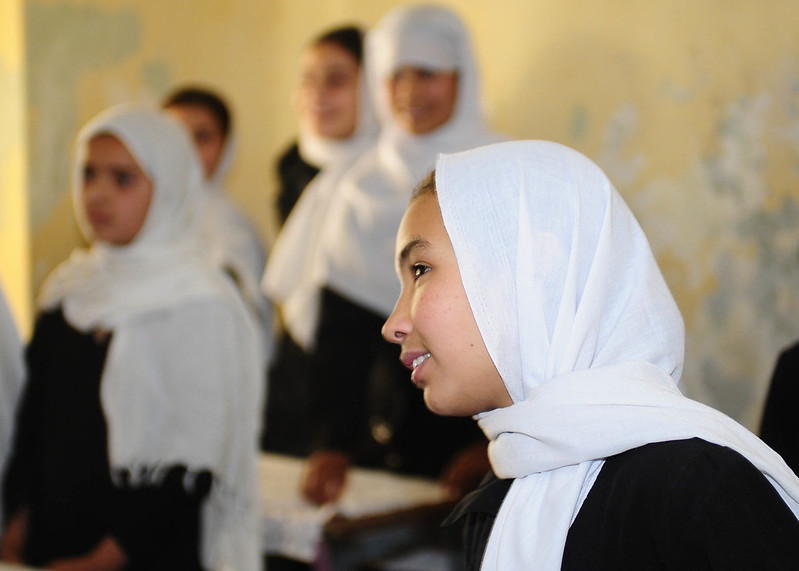Taliban nostalgia threatens 20 years of progress for Afghan girls. How the U.S. responds will be a true test of the Biden administration’s commitment to gender equality.

When assuring the American people that the U.S. was prepared for every contingency of withdrawal from Afghanistan, President Biden also promised to support the rights of Afghan women and girls. Words matter.
The U.S. withdrawal from Afghanistan left behind millions of Afghan women and girls who now face uncertain—but assuredly worse—futures under Taliban rule. Afghanistan is engulfed in an urgent humanitarian crisis affecting the country as a whole, and women and girls in particular. Now is the time for the Biden administration to show the leadership on gender equality that President Biden promised.
History has demonstrated that girls are easy for political leaders to dismiss. The Taliban of the 1990s exercised near total control over most aspects of women’s lives. Girls bore the double burden of being punished and ignored for both their gender and their age. The Taliban closed girls’ schools and banned them from public life, leaving them isolated in their homes and with strict limitations on everything from going to the doctor to what they could learn. Child marriage often meant a death sentence for Afghan girls who became mothers earlier than their bodies were ready or who suffered violence at the hands of their older and more powerful husbands. Impunity for these abuses reflected girls’ low status in the eyes of Taliban leaders. Girls were literally and figuratively shut behind closed doors, silenced, and told in both words and actions that they held no worth.
Today’s Taliban is going down that same path—desperate to turn back the clock—despite trying to brand themselves with a new, more tolerant public image. Their assurances that they will uphold women’s rights are absurd against reports of forced marriages, bans on girls and young women attending secondary schools and universities, restrictions on women going to health clinics without male relatives, and instructing all women over 20 to get married and women under 35 to register with authorities to be married off to Taliban soldiers.
Despite international pressure to form an inclusive government, the Taliban has essentially said, “Sorry, not sorry” by dismissing the idea of women in the Cabinet and insisting they should instead focus on giving birth. The lives, aspirations and rights of girls are not just getting lost in the mix—they are actively being squashed. Taliban nostalgia threatens 20 years of progress for Afghan girls.
How the U.S. responds to this will be a true test of whether the Biden administration’s stated commitment to gender equality applies in practice and beyond rhetoric. The U.S. must step up and ensure that aid to address the urgent humanitarian situation in Afghanistan identifies and responds accordingly to the impact the crisis has on girls specifically.
The U.N. has painted a bleak picture overall: There are now 18.4 million Afghans in need of humanitarian assistance. And of the 600,000 Afghans displaced this year alone, 80 percent are women and children. As in any humanitarian emergency, girls face unique additional risks, including threats of child marriage, gender-based violence and acute malnutrition. Maternal mortality in Afghanistan, already among the highest in the world even before the current crisis, is a looming concern for those who are now displaced, especially as the health system is on the brink of collapse.
U.S. funding and diplomacy can make a difference for Afghan girls, but only if President Biden puts the full weight of U.S. influence behind the humanitarian response.

U.S. funding and diplomacy can make a difference for Afghan girls, but only if President Biden puts the full weight of U.S. influence behind the humanitarian response. Already, the U.N. Population Fund (UNFPA)—an agency the Biden administration funded, reversing years of Trump-era politicization—is maintaining life-saving reproductive health and GBV services for Afghan women and girls. But the needs are great, and the resources remain inadequate.
U.S. funding for emergency aid in Afghanistan could also provide girls with temporary learning spaces and critical nutritional support. The U.S. leading global efforts to pressure the Taliban to ensure unfettered humanitarian access, including by lifting restrictions on female aid workers, could broaden access to services for more people urgently in need.
The crisis in Afghanistan spells out so clearly how girls’ lives are inextricably connected to the environment around them. How the world, including the U.S., responds to humanitarian emergencies and the girls caught in them matters. Girls in Afghanistan, and around the world, need us to see them, even in the midst of conflict and crisis.
Every year on the International Day of the Girl, we highlight the rights and accomplishments of girls globally—but what we have learned over our decades of work on inclusive humanitarian response is that our attention must last beyond this day.
We don’t need another speech or more photo opportunities. We have enough promises. What we need is for President Biden to galvanize real action. Afghan girls deserve nothing less.
Up next:












